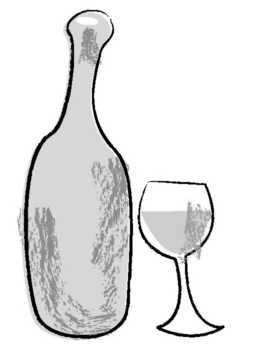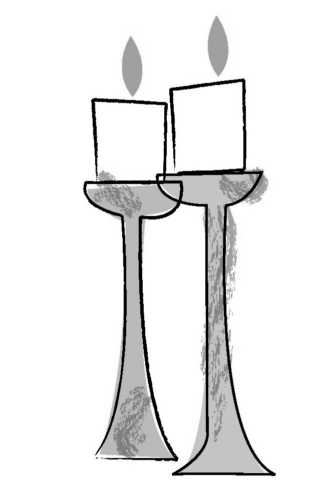Jewish Cooking Boot Camp: The Modern Girl's Guide to Cooking Like a Jewish Grandmother (16 page)
Read Jewish Cooking Boot Camp: The Modern Girl's Guide to Cooking Like a Jewish Grandmother Online
Authors: Andrea Marks Carneiro
Tags: #Cookbooks; Food & Wine, #Entertaining & Holidays, #Special Diet, #Kosher, #Special Occasions, #Religion & Spirituality, #Judaism

(Chorus)
Chanukah Songs
"Ma'oz Tzur (Rock of Ages)"
"Oh Chanukah"
(Chorus)
(Chorus)
"Not By Might, Not By Power"
"Let me tell you the one thing I have against Moses. He took us forty years into the desert in
order to bring us to the one place in the Middle East that has no oil!"
-GOLDA MEIR
Passover is all about the seder, meaning traditional fare such as charoset, gefilte fish, and
matzo ball soup. For "the Festive Meal" (as we Markses like to call it), we went with a delicious roast turkey (though you can sub in any of the brisket or chicken recipes) alongside
fresh vegetables, and Passover matzo rolls. For dessert, Aunt Frieda's nut cake is always a
winner, but Passover brownies and almond macaroons are sure to disappear just as quickly.
And what's Passover without matzo brei? Our recipe will introduce you to a secret ingredient sure to surprise and delight. If these aren't enough, be sure to check the Take-Along and
Comfort Foods chapters for more Passover-approved desserts.
Moderately Priced Red:
Recanati Yasmine Red (Israel), Kosher
Special-Occasion Red:
Yarden Cabernet Sauvignon (Israel), Kosher
Moderately Priced White:
Recanati Yasmine White (Israel), Kosher
Special-Occasion White:
Goose Bay Sauvignon Blanc (New Zealand)

1. Passover begins on the fifteenth day of the month of Nissan and lasts for seven or eight
days (depending on where you live). It usually falls in early spring.
2. It primarily revolves around the story of the Jews' exodus from Egypt after four hundred
years of slavery.
3. We traditionally observe Passover by having a seder, a family meal filled with rituals to
remind us of the story of the exodus.
4. A Haggadah is used as the basis for the service during a seder. It tells the story of how
God rescued the Israelites from slavery in Egypt and traditionally contains songs, prayers,
and narration for those attending the seder. It can be passed on via family, school, or temple or created to fit one's own family needs. (See our Haggadah sidebar for more information on creating your own.)
5. A seder plate should sit on the table and contain: Maror (horseradish to represent the
bitterness of slavery); Charoset (apples, nuts, and cinnamon, a symbol of the maror that
slaves used to build Egyptian structures); Karpas (often parsley or celery, which is dipped
into salt water to represent the tears shed during Egyptian slavery); Z'roa (a shank bone,
which stands in for the Paschal lamb, a biblical Passover sacrifice); and Beitzah (a roasted
egg believed to be representative of the festival sacrifice as well as a symbol of mourning
for the loss of the temple in Jerusalem). A separate plate containing three pieces of matzo
should be on the table, as well as a dish of salt water for dipping the green vegetable. Last,
the host should place an extra cup of wine on the table for Elijah.
6. Children play a large role in the Passover seder, and the youngest child often asks the
traditional "Four Questions."
7. The afikomen is the last piece of food eaten at the seder. It is traditionally hidden for
children to find and then "negotiate" for its return.
8. For all of Passover, Jews are forbidden to eat or posses chametz, which consists of any
wheat, spelt, barley, oats, or rye that has come into contact with water for more than eighteen minutes.
• Passover is the oldest continuously celebrated Jewish festival.
• The three pieces of matzo symbolize the three classes of Jewish people in ancient times:
the Kohens, the Levites, and the Israelites.
• Both Coke and Pepsi make "kosher for Passover" versions of their sodas.
• One of the most popular Haggadahs in the United States during the beginning of the twentieth century, and the first mass-produced adaptation, was arranged, edited, and translated by a woman named Lillie Cowen.
• Passover's name comes from the last of the ten plagues, in which Jewish homes were
"passed over" during the killing of the firstborn male children.
• According to The National Jewish Population Survey (NJPS) 2000-01, 4.3 million of the
5.2 million Jews living in the United States attend a Passover seder.

"Instead of a seder, one year my family and I decided to do something a little different ... so
we had a Yiddish lesson. It was hilarious!"
-JILL, NEW YORK CITY, NEW YORK
"My wife and I live far from our families, so my mother makes care packages for the holidays
every year. Usually it's overloaded with food, but she looks for weird objects to include. One
year for Passover she sent us a box of plush toys representing the icons from the seder-an
egg, a lamb shank, etc.... "
-SCOTT, HOLLYWOOD, FLORIDA
"Here in Brazil on Easter we have a big thing about chocolate eggs. One month before the
holiday all the shops and supermarkets sell a variety of huge chocolate eggs filled with
candy, and people give each other those chocolates-it's a big thing for kids. When we were
younger, my grandparents used to hide the chocolate eggs on Passover instead of matzo,
so we were more motivated to look for it around the house ... and then after negotiate the
afikomen."
-LINA, PORTO ALEGRE, BRAZIL
"Since my niece, Rachel, was about sixteen years old, she has kept a list of everyone who has
attended my sister's seder in Kansas City, Missouri. It's in the back of one of the Haggadahs,
marked with her name on it. Every year when we go to Kansas City, it's fun to see who is
there, who attended last year and the year before that. It's also a time to add the names
of husbands and wives and babies, and to see how the family is expanding, as well as to
remember those who are no longer with us."
-DEDE, MIAMI, FLORIDA
"My mom goes all out on Passover to help explain the plagues to my nieces through live table
theater. I mean, the woman actually buys rubber bugs to signify locusts and throws them on the seder table. Boils are cotton balls with band-aids, and red dye is water turning into
blood ... it's a real treat to see live!"